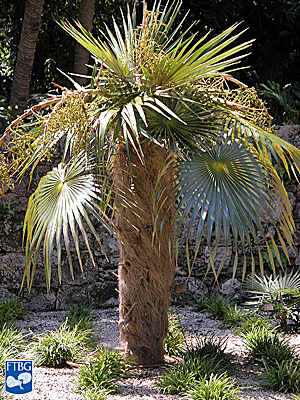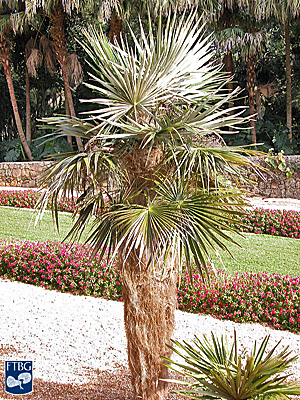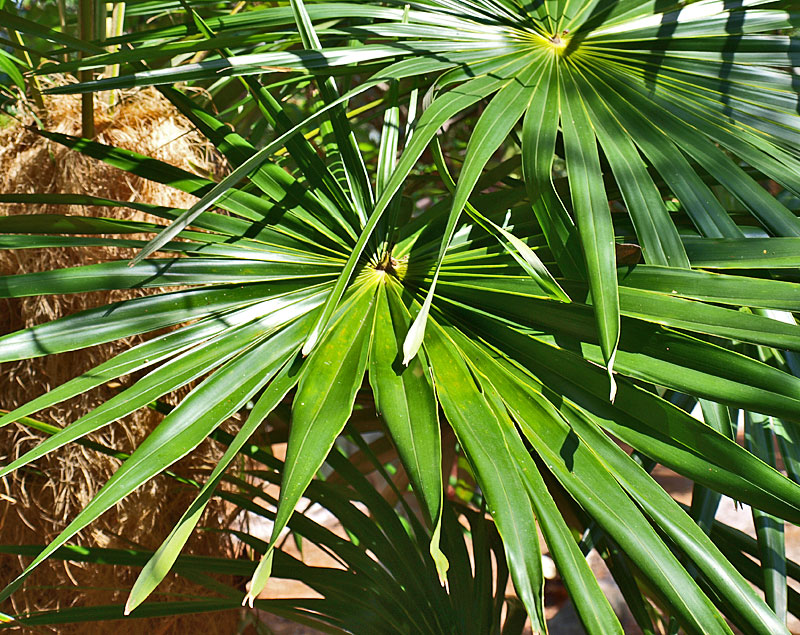Coccothrinax crinita
|
Coccothrinax crinita habit. Photograph courtesy of Fairchild Tropical Botanical Garden, Guide to Palms http://palmguide.org/index.php |
|
Coccothrinax crinita habit. Photograph courtesy of Fairchild Tropical Botanical Garden, Guide to Palms http://palmguide.org/index.php |
|
Coccothrinax crinita close view of fibers |
|
Coccothrinax crinita leaves |
|
Coccothrinax crinita upper surface hastula |
|
Coccothrinax crinita leaf lower surface |
Common name
old man palm
Description
Stems: Solitary, erect stems, to 10 m tall (usually shorter in cultivation), up to 20 cm in diameter. Old leafleaf:
in palms -- the leaf blade (which is usually divided into leaflets or leaf segments), the petiole (or leaf stalk) and the sheath (which forms the attachment of the leaf to the stem)
bases cover the stems in a dense layer of woven fibers with long, pendulous tips that extend away from the slender stem. Leaves: Palmatepalmate:
like the palm of a hand; fan palms have palmate leaves that are usually divided into leaf segments arising from a central point, although a fan palm may have entire leaves (e.g., <em>Licuala grandis</em>)
, induplicateinduplicate:
Most palm leaflets or leaf segments are obviously folded. If the folds create a V-shape, with the midrib lower than the margins (so that rain might fall "into a valley"), the folding is induplicate.
, with a nearly circular blade (about 1.5 m across) divided more than three-fourths its length by numerous, narrow segments that split at the tips. The upper leafleaf:
in palms -- the leaf blade (which is usually divided into leaflets or leaf segments), the petiole (or leaf stalk) and the sheath (which forms the attachment of the leaf to the stem)
surface is bright green; the undersurface, green to silver-gray; transverse veinlets are not obvious. The fibrous leafleaf:
in palms -- the leaf blade (which is usually divided into leaflets or leaf segments), the petiole (or leaf stalk) and the sheath (which forms the attachment of the leaf to the stem)
sheath has two layers, and the unarmed petiole is not split at the base. Flowers and fruits: Inflorescence inflorescence:
the reproductive structure of a flowering plant, including palms, consisting of flowers and associated bracts
arches above the the leaves, to 1.5 m long, branched to two orders with up to 5 primary branches. The yellow flowers have both male and female parts. The fruits are spherical (7-20 mm in diameter) and black or purple when ripe.
Diagnostic features
Field: Erect, fan palms with stems covered by a dense layer of woven fibers with long, pendulous tips.
Lab: No visible transverse veinlets.
May be confused with
Thrinax species, but the petioles of Thrinax palms split at the base while those of Coccothrinax do not.
Distribution
Native to Cuba
Scientific name
Coccothrinax crinita Becc.
Family
Arecaceae/Palmae
Synonyms
Antia crinita (Becc.) O.F.Cook
Thrinax crinita Griseb. & H.Wendl. ex C.H.Wright








